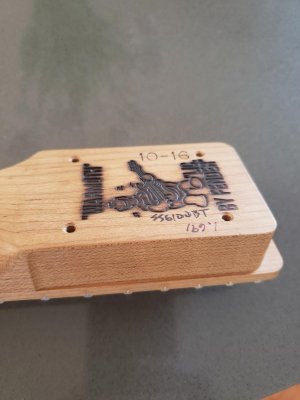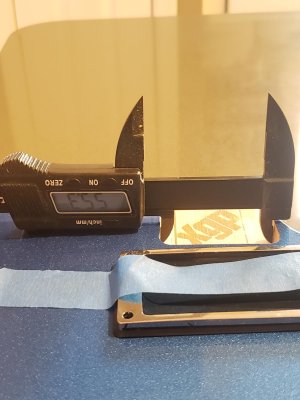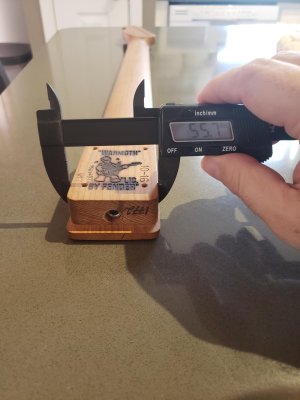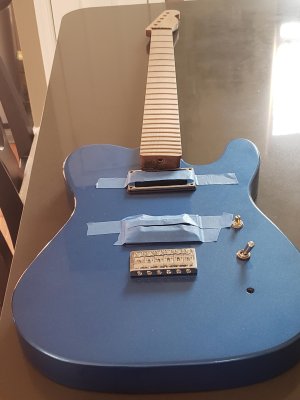Hi Everyone,
I just signed up and first time posting here. I'd bet this topic would be discussed quite a bit but couldn't find any posts easily discussing this question.
I just ordered a roasted maple baritone tele neck with no finish, (none needed with roasted maple) & stainless frets. The fretwork and quality are absolutely gorgeous.
I have a few tele bodies laying around. I was going to mount this neck onto a GFS Tele Body with dual humbucker routes I have ready to go. I tried fitting it and the neck is way too large for the pocket. I also tried the neck on a super high quality Musicraft Tele body I have and also too large for the body; this leads me to believe the constant is that the neck is a little wide for a standard Fender pocket.
I am wondering what the opinion is on sanding to get a neck to fit properly. Is it customary to sand just the neck, or the pocket, or both?
I've assembled roughly 15 guitars in the past and if there were fit issues I was generally sanding the neck (trying to be even on both sides) and the pocket as well a bit. Also, 9 times out of 10 the necks just fit without any alteration needed. I have some experience but I do not consider myself an expert at all. I was wondering what the expert builders do in this case and if there is a preference of just sanding the neck or just the body to fit. This is one of the nicest necks I have ever laid my hands on and want to make sure I am doing this build the right way. The neck may not be married to the GFS body for ever either so I would like to be careful not to do anything regretful if I wish to mate this neck to another body in the future. In the past none of the necks or bodies I have used have been to this level of quality.
Also, I called Warmoth to ask and they didn't have a canned answer; they actually suggested I look at the forum. To be radically transparent I am not calling the baby ugly with Warmoth and saying the neck is the wrong size; I realize the nuances of working with wood and that wood is a unique building medium that does expand and contract. Just trying to do my due diligence on this subject and try to make sure this neck is preserved for years to come. Also, I have left the neck out of the packaging roughly 7 days to acclimate to my house's environment. I am in no rush to assemble this project, I'd rather take my time and do things the right way.
Also- one other side topic. For all those out there building Baritone guitars or using conversion necks. I am interested in hearing feedback on your tuner choices. I have a beautiful set of Sperzels laying around (used but nice) and wanted to use those but the 6th String tuner hole size will not fit the 72 gauge baritone strings. Has anyone ever drilled a Sperzel out for this? I'd bet that violates the warranty- i a plan to call Sperzel and ask if they have a Baritone sized tuner you can but for this purpose or if they endorse drilling knowing it will violate the warranty.
Any info is really appreciated. Thanks in advance. ~Ed
I just signed up and first time posting here. I'd bet this topic would be discussed quite a bit but couldn't find any posts easily discussing this question.
I just ordered a roasted maple baritone tele neck with no finish, (none needed with roasted maple) & stainless frets. The fretwork and quality are absolutely gorgeous.
I have a few tele bodies laying around. I was going to mount this neck onto a GFS Tele Body with dual humbucker routes I have ready to go. I tried fitting it and the neck is way too large for the pocket. I also tried the neck on a super high quality Musicraft Tele body I have and also too large for the body; this leads me to believe the constant is that the neck is a little wide for a standard Fender pocket.
I am wondering what the opinion is on sanding to get a neck to fit properly. Is it customary to sand just the neck, or the pocket, or both?
I've assembled roughly 15 guitars in the past and if there were fit issues I was generally sanding the neck (trying to be even on both sides) and the pocket as well a bit. Also, 9 times out of 10 the necks just fit without any alteration needed. I have some experience but I do not consider myself an expert at all. I was wondering what the expert builders do in this case and if there is a preference of just sanding the neck or just the body to fit. This is one of the nicest necks I have ever laid my hands on and want to make sure I am doing this build the right way. The neck may not be married to the GFS body for ever either so I would like to be careful not to do anything regretful if I wish to mate this neck to another body in the future. In the past none of the necks or bodies I have used have been to this level of quality.
Also, I called Warmoth to ask and they didn't have a canned answer; they actually suggested I look at the forum. To be radically transparent I am not calling the baby ugly with Warmoth and saying the neck is the wrong size; I realize the nuances of working with wood and that wood is a unique building medium that does expand and contract. Just trying to do my due diligence on this subject and try to make sure this neck is preserved for years to come. Also, I have left the neck out of the packaging roughly 7 days to acclimate to my house's environment. I am in no rush to assemble this project, I'd rather take my time and do things the right way.
Also- one other side topic. For all those out there building Baritone guitars or using conversion necks. I am interested in hearing feedback on your tuner choices. I have a beautiful set of Sperzels laying around (used but nice) and wanted to use those but the 6th String tuner hole size will not fit the 72 gauge baritone strings. Has anyone ever drilled a Sperzel out for this? I'd bet that violates the warranty- i a plan to call Sperzel and ask if they have a Baritone sized tuner you can but for this purpose or if they endorse drilling knowing it will violate the warranty.
Any info is really appreciated. Thanks in advance. ~Ed






